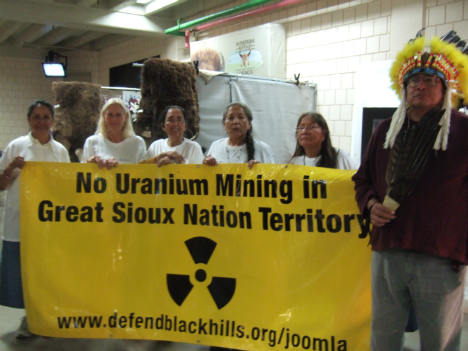
Mike Howe, Halifax Media Co-op
Elsipogtog War Chief John Levi was today sent to jail until Monday morning at 9:30am, which, according to the presiding judge, was the “earliest convenient time” to set bail.
Levi stands accused of two charges, both related to an anti-shale gas action that took place on June 21st. The first, mischief, is most likely related to the actions of four people, three of whom went out onto highway 126 into the path of SWN Resources Canada’s seismic testing trucks. These four people were arrested – along with eight others on that day – and Levi stands accused of telling protesters to “stand their ground”.
It was three later arrests that broke through an RCMP line and attempted to halt the moving trucks. One woman was also arrested and subsequently punched in the mouth by RCMP, as she attempted to get to her partner, who had thrown himself under the bumper of a moving truck.
Levi also stands accused of obstructing justice, which, actually, is allegedly related to him and I leaving highway 126 together in his truck on June 21st. For that day, I stand accused of ‘threatening’ an RCMP officer. Yesterday, when I was first charged at RCMP ‘Codiac’ station in Moncton, I was also charged with ‘resisting arrest’. This was later changed to ‘evading arrest’ and then subsequently to ‘obstruction of justice’ for alllegedly walking away from the officer that I allegedly threatened, who then allegedly arrested me.
That I was not charged with anything until yesterday, July 4th, suggests that officer Richard Bernard, who allegedly did the arresting, kept the matter of my charges – and subsequently at least one of John Levi’s charges – totally to himself.
There have been ample opportunities to charge me – and Levi – with whatever the RCMP might have liked. Why they chose not to do so, and then arrest us two weeks later, must remain in the realm of conjecture for the moment.
For example:
On June 22nd I was pulled over and my licence was run by the RCMP. There was no charge against me.
On June 24th I was highly visible at an anti-shale gas action in Browns Yard, New Brunswick. No officer approached me to inform me of my arrest.
On June 30th, I gave two RCMP officers a statement in relation to a fire to which I was the first responder. Not only was there no charge at this time, but these RCMP officers then offered me “financial compensation” if I would alert them to information related to the fire or any plans I might hear of that might endanger people or equipment.
This does raise the question:
If no one in the RCMP, save perhaps officer Rick Bernard, knew that I was charged with anything, then how could John Levi have possibly known that he was obstructing justice by having me in his truck when we drove away from the site of the 12 arrests on June 21st?
Levi, for his part, has also suffered numerous threats from the RCMP since June 21st.
“He’s received a lot of phone calls and texts from RCMP, demanding and even threatening him.” said Amy Sock, one of the encampment’s spokespeople, outside of the Moncton courthouse.
“[The RCMP have been saying] they want to see him today, and if not today then they’re going to catch him one day.”
It is also important to note that Levi was never charged with anything until I was charged yesterday. I was arrested at 12:34pm; Levi’s parole officer was served with a notice to appear at approximately 2pm.
Levi is currently on probation for attempting to exercise Treaty fishing rights.
It is also important to note that both my arrest and Levi’s arrest just so happen to have occured yesterday, July 4th. This is the first day that SWN Resources Canada has worked in over a week.
In court this morning, Norma Augustine, Levi’s aunt, attempted to plead with the judge to overturn the decision to imprison her nephew until Monday. The presiding judge stood up while Augustine – an Elder in the Elsipogtog community – was in mid-sentence, and walked away. Many in the nearly packed courtroom turned their backs on the judge as he exited.
“Just because he’s in jail does not mean that this fight will be over. In fact it means more support. More people will be here,” said Sock. “Look at all these people that came here and left at 8 o’clock this morning for John Levi. Because we believe in him and we believe in what he’s doing.”
SWN work update
Unconfirmed sources say that SWN Resource Canada has halted work for the day on ‘Line 5′, the back woods seismic line west of highway 126. The work stoppage is apparently related to a threat for workers’ safety.













